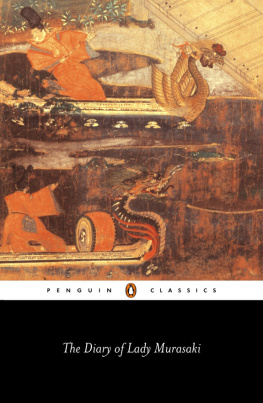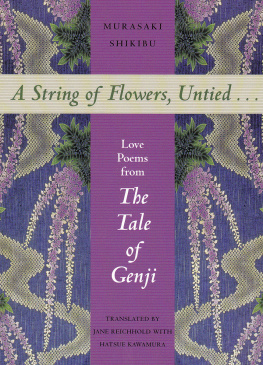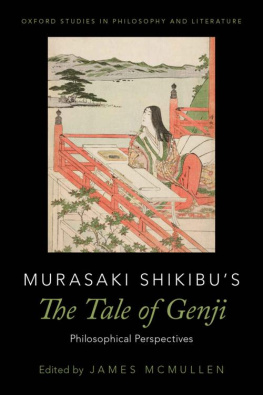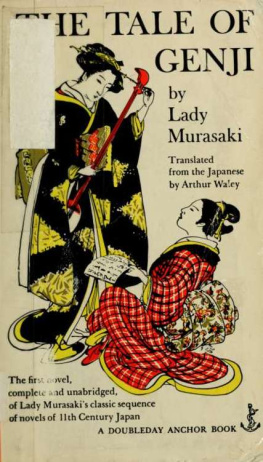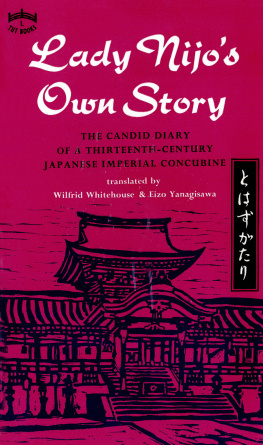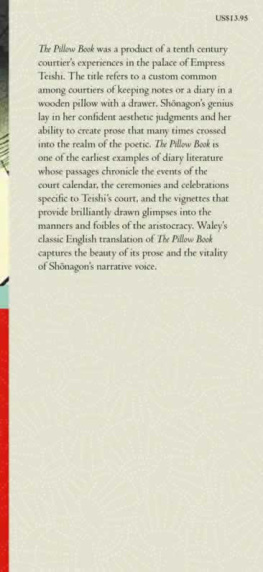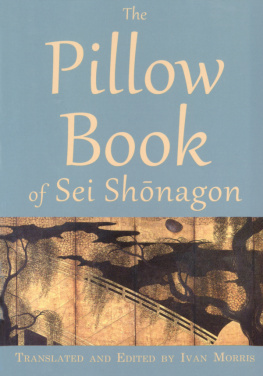APPENDIX 1
GROUND PLANS AND MAP
GROUNDPLAN 1
Tsuchimikado Mansion
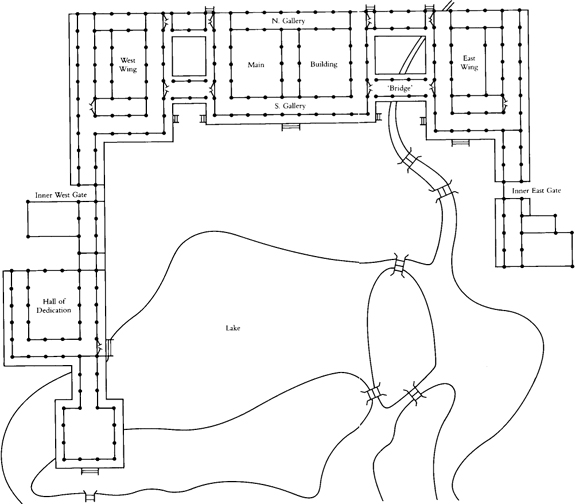
GROUNDPLAN 2
Tsuchimikado Mansion - Detail
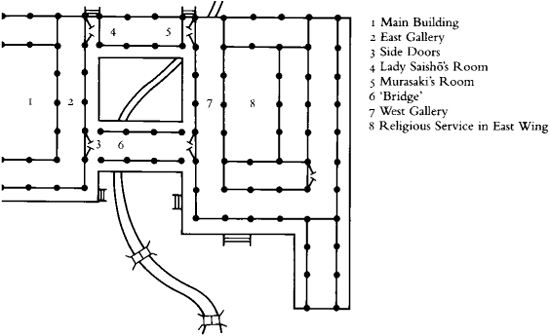
GROUNDPLAN 3
Birth of Atsuhira
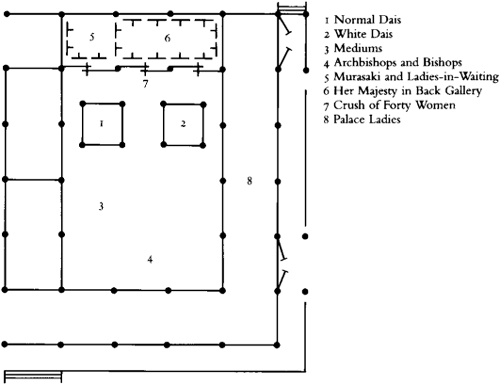
GROUNDPLAN 4
The First Bath
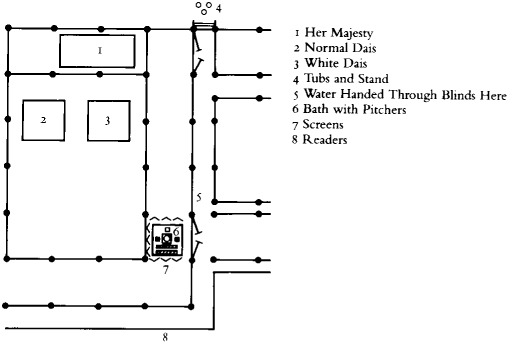
GROUNDPLAN 5
Fifth-Day Celebrations
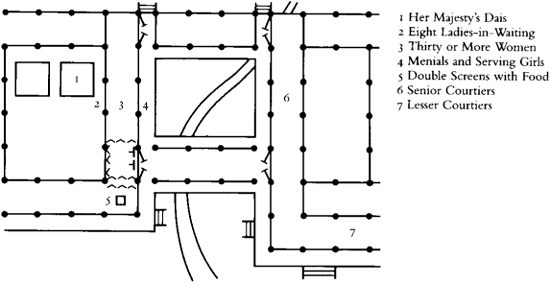
GROUNDPLAN 6
The Imperial Visit
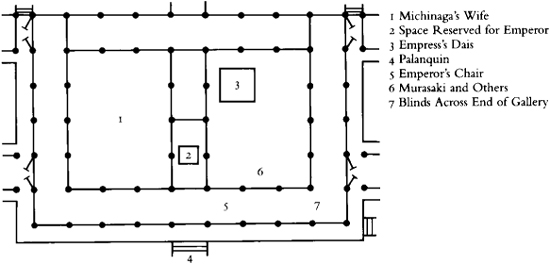
GROUNDPLAN 7
Fiftieth-Day Celebrations
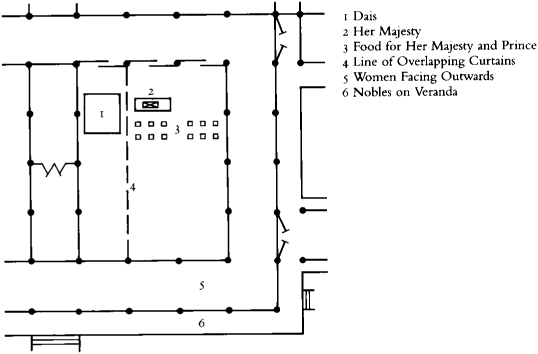
GROUNDPLAN 8
Ichij Palace
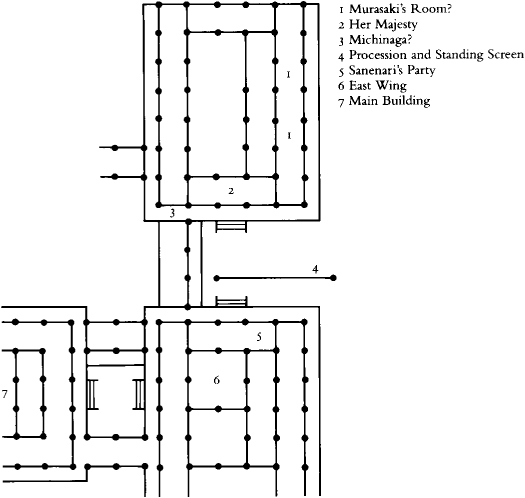
The capital city in Heian Japan
APPENDIX 2
ADDITIONAL SOURCES
In part because the birth of Prince Atsuhira was such an important event for Michinaga and his branch of the Fujiwara family, there are a number of extant records in Sino-Japanese that cover similar ground to Murasakis diary. Not only do they provide a background of factual details which often help us to understand her diary correctly, but they also reveal the different perspective that men writing in Sino-Japanese and women writing in pure Japanese brought to their description of events at court. Translated here are a few relevant sections from two of the three anonymous descriptions, Fuchiki A and B, taken from a manuscript in the Imperial Library entitled Gosanki burui (Classified Records of Imperial Births), and from Fujiwara no Sanesukes diary the Shyki. Except for Fuchiki B these extracts cover the main events during the ninth month of 1008.
(a) Fuchiki A
(Probably of much later provenance and influenced by Murasakis diary)
Kank 5 (1008).8.11. The furnishings for Her Majestys lying-in were brought over from the Palace. One dais made of white wood with damask curtains and five supports each painted white; three pairs of five-foot screens and three pairs of four-foot screens made of white damask backed with black, black and white design on the borders, and the usual gold fittings; three pairs of four-foot curtain frames and two pairs of three-foot frames with damask curtains; thirteen thick mats with borders of white damask; everything else had damask edging too; one extra cover edged with figured silk. Everything packed in black lacquer boxes and containers.
9.11. Fair. Her Majesty gave birth to a son in the Tsuchimikado mansion about midday. Yorisada arrived outside the Palace gates and had a Chamberlain announce the good news to the Emperor. Then he was ordered to present the sword to Her Majesty. He returned to the mansion, stood outside the centre west gate, and had Tsunefusa announce him. Then he proceeded to where mats had already been laid down on the veranda in front of the blinds along the southern gallery. Michinaga talked to him for a moment and then presented him with a set of womens robes. He went back down the southern steps, bowed for a second time, and returned to the Palace; his attendant received two rolls of silk. His report was sent in to the Emperor and received by the Middle Counsellor Elect just as in the case of the messenger to Ise. The first bath was held at about eight that evening. Two clerks and four scribes wearing white vestments carried in the bathtub and various other utensils, bringing them to Her Majesty along the east bridge. Then Doctor of Letters Hironari, who was carrying the opening passage from the Records of the Grand Historian, led in twenty bowmen, ten of Fifth Rank and ten of Sixth. They came in from the same direction, and stood facing north, ranked west to east. Hironari started his reading. When he had finished, they all left. The evening bath was held late at night. Doctor of Confucianism Munetoki did the reading (from the Classic of Filial Piety). Takachika was also a reader.
Events on the third day. Her Majestys Household arranged the celebrations; six trays with silver utensils. The nobles, senior courtiers, and masters all had a banquet. There was food for the retainers and also betting. The baby prince was given a pair of clothes chests made of nettle-tree wood with silver clasps and set on a Chinese table covered with a cloth.
Events on the fifth day. Michinaga arranged the celebrations. Six trays with silver utensils. Two cabinets were put out on the veranda and the food was placed in them. There was a banquet, food for the retainers, and gifts, a womans wardrobe for the nobles, robes for the retainers. Today those with the rank of scholar and student in the Kangakuin came in procession to present their congratulations. Scholar Tokitaka was also present to bow and receive a gift.
Seventh day. Fair. The seventh night after the birth. Celebration held under the auspices of the Palace. There was food, six trays made of nettle-tree wood with mother-of-pearl inlay. The surface was embossed in places. The cloth too was intricately woven and inset with ivory. The food boxes, chopstick-rests, sake cups, and bowls had all been prepared by the Imperial Table Office. There were twenty-five sets of robes, 120 rolls of silk, 300 lbs of cotton, and 500 pieces of Shinano cloth, all packed in ten large boxes; fifty banquet settings from the Bureau of Palace Storehouses, fifty meals from the Granary, and twenty meals for retainers from the Kitchens of the womens quarters at the Palace. The Imperial messenger Michimasa, together with an accountant, was given a gift and reported back to the Palace. Officials from the Imperial Table Office came to the bottom of the steps, where women servants took the food and presented it. That done, the officials were given one roll of silk each. Akimitsu and the other nobles held a banquet in the east wing; they sat in the southern gallery, facing north and ranked west to east. The three Doctors of Letters were also present. Then the nobles went over the bridge, sang congratulatory songs and received presents in return. Ministers received womens dresses; Tadanobu a womens wardrobe and baby clothes; those between the rank of Major Counsellor and Adviser womens dresses, one robe of damask, and baby clothes; senior courtiers and masters one roll of silk each, except that two of the more important men had baby clothes in addition.
(b) Fuchiki B
Kank 5 (1008).9.11. Fair. Her Majesty gave birth in the Jtmonin; the north gallery of the central chamber was chosen as the place of birth. She had been having contractions since dawn on the tenth, so at about four that morning they moved away the normal dais and set up one made of white wood with cicada-wing curtains and gauze ribbons; there were 12 screens of white damask and the dais itself was also white with gauze curtains and ribbons. They also provided mats with white borders. The dais, thick mats, etc., had previously been arranged by Michikata and Sadasuke on imperial order. One day last month, the eighth, Sadasuke, acting as imperial envoy, had brought them over from the Palace. He was given a gift of a set of womens dresses. The accountant Tahiji no Tokimasa received womens robes, and the attendant from the Secretariat one roll of white silk. The other attendants received one roll of red silk each. Then the rice for casting was prepared in six white tubs, arranged by the Household. Meanwhile many prayers were offered up. About noon the baby was safely delivered. They called up the Yin-Yang diviners, Kamo no Mitsuhide, Abe no Yoshihira and Agata no Tomohira, who were given gifts, three rolls for Fourth Rank, two for Fifth Rank. They were asked to calculate the calendar of events for the first giving of the breast and other ceremonies. The duty of giving the breast was given to Tachibana no Tokushi because she had been the Emperors wet nurse. She received a womans wardrobe as a gift. The three readers were named: Doctor of Confucianism Nakahara no Munetoki, Doctor of Letters Fujiwara no Hironari and e no Takachika. There were twenty bowmen; ten of Fifth Rank, e no Kagemasa, Ki no Tadamichi, Taira no Masayoshi, Fujiwara no Sueyori, Fujiwara no Takanao, Sugawara no Tamemasa, Fujiwara no Tomomitsu, Minamoto no Nagamitsu, Minamoto no Tadataka, Fujiwara no Sadasuke; and ten of Sixth Rank, Takashina no Arihira, Minamoto no Tameyoshi, Fujiwara no Naganobu, Fujiwara no Chikanori, Fujiwara no Ienari, Fujiwara no Mochimichi, Takashina no Yorihira, Fujiwara no Akinobu, Minamoto no Yorikuni, Tachibana no Yoshimichi, all dressed in white.

